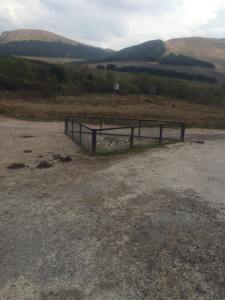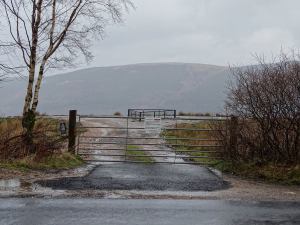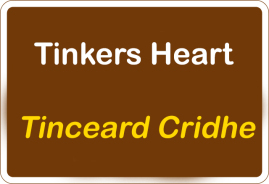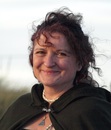Fiona Tinker's Blog, page 5
October 4, 2016
What Does Good Interfaith Education Look Like?
This was the question posed by an Interfaith activist based in Europe. He had the idea of a collaborative book focusing on Interfaith and education in various European countries. It’s an excellent premise for a thoughtful volume. Unfortunately, I won’t be submitting my essay as part of this as I really don’t think it is necessary for a publisher to demand the copyright of an author’s work – it’s a bit odd, to be truthful; and certainly not something I’ve come across before.
So I’m left with a little lost and lonely chapter on why Paganism ought to be included in the RME Curriculum in Scottish schools. It’s linked below, for interest. In time, I will link the volume, should it be completed.


July 27, 2016
Soul of the Earth: The Awen Anthology of Eco-Spiritual Poetry, Ed. Jay Ramsay
This beautiful collection of poetry centres on our earth as a living entity and on whose survival our own lives depend. Ramsay states in his introduction: ‘We are being asked, individually and collectively, to make an absolute basic spiritual choice for life.’ The spiritual choices in this collection are positive, life-affirming declarations of love for this planet from a variety of perspectives.
Each of the twenty-one contributors to this book of poetry has something vital to contribute to the concept of eco-spirituality; and the myriad of explorations on this theme will resonate with readers quietly contemplating this important question explored in the collection. It is difficult to single out individual poets / poems as the entire volume is soul food. Apologies to those poets not mentioned in this review – rest assured your poems too were appreciated.
So – what are these spiritual choices? Karen Eberhardt –Shelton’s Misplaced Calibrators explores the disconnection between modern life and the things that really matter. The natural world in her observational poem is removed from the personas within it by the personas’ obliviousness to patterns and meanings of life:
Mum walks the springer spaniels while talking
On her mobile phone;
Ladybirds crawl away, bees watch in amazement.
The ladybirds flee; the bees are stunned. The loss of all the old wisdom of bee-keeping, part of the ancient knowledge that allowed us to survive as a species is wonderfully captured in this personification and their astonishment as they observe this human so indifferent to their presence. No telling the bees here.
The whole poem reverberates with old knowledge and the personifications used are more than a literary device. The question asked at the end: ‘What would they do if there was no moon or sun or seasons ever again?’ is the heart of this poem and the gentle meditative wisdom at its centre.
Jehanne Mehta’s Hymn to the Earth is a stunning panegyric reminiscent of classical works in praise of Gods and Goddesses. The earth is portrayed as a beautiful young woman who has many moods:
She is lovely in the springtime in her dress of gold and purple;
She is lovely in the summer in her robe of living green…
The poem invites its reader to walk the seasons and to appreciate our world as a living, breathing entity. It encourages the reader to think about the earth and what it means. But it does more than this. It involves the reader at a visceral level and makes them contemplate a relationship with the earth as they might contemplate a relationship with a lover. The power in this poem is palpable and it is perfect for immersion in spiritual practice, regardless of path.
Lynne Wycherley’s Substitute Sky picks up the same theme as Karen Eberhardt –Shelton’s poem: the disconnect between the appearance of living and of life itself:
…we stare at screens,
A sly fluorescence, a not-quite sky…
(…)
Less talk,
Less laughter, less sun on our skins;
Our lives on hold, our children wired in.
The imagery of children entrapped by wires is a powerful punch to the gut and reminds the reader that a literal tying down of children to control them would – rightly – be viewed as child abuse, but our acceptance of a metaphorical tying of children by the unseen wires and cables of technology is an abuse we seem to accept without question. Such sad children are all too often the norm and it can sometimes seem they neither know nor care that they are in the thrall of machines.
The eco-spiritual question asked of the reader throughout the book is how we interact with our modern world and the technology within it – and how we teach our children that a machine is a good servant but a bad master. This is an important, pertinent and relevant question and the result of not addressing it is encapsulated in the final couplet of Wycherley’s poem:
Core addiction: captive eyes.
Outside the real world breathes, and dies.
These three poems are but a small taste of the treasures contained within this volume. Each of the poets brings their own interpretation to the question of eco-spirituality and each offers something of themselves and of importance to the reader.
Fiona Tinker
Soul of the Earth: The Awen Anthology of Spiritual Poetry, Ed. Jay Ramsay, (England: Stroud, Awen Publishers, 2010.) £12.


Pooka Pages Magazine for Pagan Kids – Lughnasadh 2016
The new edition of Pooka Pages is also now ready for free download – it’s been a productive day! Please enjoy:


Heart of the Travellers Magazine
May 9, 2016
Heartache
Do you remember when you were a child and you had sweeties that you just wouldn’t share? Not because they were extra special to you, just because they were yours and you didn’t see why you should share them? Not even if the more sensible part of you knew that by sharing, life could be so much better – not only for you, but for a lot of people around you? Imagine the lesson about what you share is returned to you many times over was one never learned.
This is the situation holding hostage the Tinkers’ Heart.
The Heart beats again to the rhythm of a culture, waiting to be loved and shared once more with the Traveller and Settled community alike. A Heart that won National Monument Status after a long, hard slog to get those concerned with such matters to recognise that yes, this place is important to so many people. Yet the Heart is in the clutches of someone who seemingly won’t share their metaphorical sweeties and is suffering broken promises from Argyll and Bute Council.
The landowner rents the field where the Heart is out to a cattle farmer. They’re very lovely beasties: great big Heilin Coos that would happily grace any picture postcard of Scotland, all orange shaggy fur and big horns. You know, the kind of picture card tourists like to send home. What tourists won’t like, if they’ve any sense, is to get up close and personal with the live animals. Nor will they like to navigate their way through cow pats to reach the Heart.
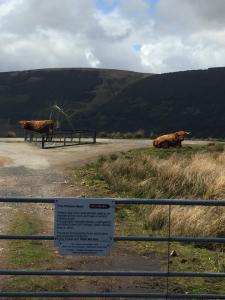
Kyle Renton May 2016
The Heart doesn’t like the cows much either because they scratch themselves against the cage that is meant for protection. They leave dung around the perimeter.
Add to that the dump of tarmac at the gate on the road and the perilous path of stones and small rocks that suddenly appeared and you’ll get the idea that this is not an attractive visitor location. It won’t be long before the cattle break the cage – what then for the Heart?
Argyll & Bute council promised signage and the opening of an old layby for parking. Neither has happened. Our Committee, who fought for the recognition and scheduling of the Heart, have put plans forward to enhance the location that is in keeping with the natural landscape. We have asked to buy the small piece of land where the Heart lies – all to no avail. These sweeties are not for sharing.
Yet.
The Heart is important to the local settled community too – Here We Are is the local heritage organisation based in Cairndow and they have done sterling work in the area. I get the feeling they would be happy to work together with us to make this little spot a happy place, a tourist destination and a place whose importance to both communities is celebrated. But they are in the unenviable position of being between a rock and a hard place. They have done their best in difficult circumstance but it’s not their bag of sweeties. If it were, they’d have passed them around long before now.
Added to this are the complaints received by our committee about the state of the Heart:
Getting a lot of flack from people who supported our campaign to have the Tinkers’ Heart scheduled. They are finding the place in a state and can’t understand why this is the case. A Canadian couple thought we’d let the Traveller culture down. It took a lot of convincing that this is not our fault. Although there have been weak promises, we are getting no support from locals nor Argyll and Bute Council. Our group ‘HOTT’ wrote to the farmer leasing the land where the Heart of white quartz stone is situated and asked if he’d take the cow feeder further down the way, where there are acres of ground. We explained that the Heart is now a national monument, therefore there will be visitors, and it’s a shame to ask them to side-step piles of dung, but he continues to ignore us. The Landowner has already made her views clear on the site and they are insulting! This place is the only one of its kind in Scotland; you’d think there would at least be a sign. We are now considering another Petition. (Jess Smith)
And that’s where we are with this. Once the new Parliament convenes on Thursday, we’ll get moving with a new petition. In the meantime, please spread the word about the site and the true reason for its neglected state.


April 25, 2016
Heart of the Travellers Magazine
One of the many good things that came out of the campaign to have the Tinkers’ Heart recognised as a Monument of National Importance by Historic Scotland was a magazine that would celebrate Scottish Travellers Culture and their part in the story of this land.
We’re now on the fourth edition. It’s free to download
and if you fancy having a wee look at our website, it’s here: http://www.heartofthetravellers.scot


Places of Truth: Journeys into Sacred Wilderness – Jay Ramsay
Places of Truth: Journeys into Sacred Wilderness – Jay Ramsay
This book is a collection of Ramsay’s poetry written from 1986 to the present and previously published elsewhere as discrete texts. By bringing these works together in one collection, Ramsay invites us to share his thirty-year journey across a variety of sacred landscapes, thus allowing the reader an insight to his experiential interactions with the genius loci of places ranging from Scotland to Sinai. Ramsay’s journeying is both physical and metaphysical and through his poetry, he combines these strands to arrive at his inner core, to realise the truth to be found in the silence of the wildernesses.
Not all poems will talk to all readers and this is a truth of itself. However, readers of Ramsay’s poetry are likely to be an audience who recognise the reality of places in the world that are mirrors which reflect the soul, leading to a sense of oneness. It is for these readers Ramsay’s poetry will sing in the way the poet intended.
Yet Ramsay’s poetry is deceptively simple. There are no great conceits of metaphorical complexity to work through, nor any great Augustan classical references to wrestle with in order to fully understand the poet. Ramsay speaks from the heart to the heart; ideas and feeling flowing to and fro, from the human to the sacred, from the seeker to the found. It is in this deceptive simplicity that the complexity of Ramsay’s Awen is discovered.
There are too many areas of this book that merit discussion and space allows for mention of just a few examples. It is hoped those chosen will whet the appetite to explore the entire text.
Trwyn Meditations call on the vast landscape at the edge of Snowdonia in Wales as a place of truth. His initial poem explores the sensations of the land, sea, sky as he experiences them:
… a slight breeze
begins
between my ears
a curlew’s cry
the water’s liquid note
down arms
and legs
to the earth’s pull…
The structure of his sentences reflects another truth – that of the general separation of mind, body and spirit can become disjointed in the mundane world we have to live in. In a place of truth and a mirror of what is really real, this psychic separation is not welcome. As Trwyn works its magic, Ramsay becomes one with the spirit of the place and his journey into that oneness is reflected in the structure of the poem:
… heart’s
breath…
By the end of this first section, Ramsay is connected to the liminal space and his awareness / oneness with Awen is in view for those who see. Those of us who also journey in places of truth will recognise much of the experiential experience in this poem. Indeed, the heart-song:
No need to speak;
Most things
Have a habit of sounding pompous
Or trivial
In this place of truth
is instantly recognisable, and not only for the paradox it contains. To share the oneness is to feel. Not think. Yet it is think that provides the means to communicate an experience that can only be felt by the individual undertaking the journey to the centre.
By the Shores of Loch Awe held particular interest as this part of Scotland holds the both the bones of ancestors and the memories of the future in the shape of a white quartz heart in the hills a little way to the east. This has been a sacred gathering place for Scotland’s Travelling People for many centuries. When Ramsay poses the question: ‘can you think like water?’ he taps lightly into the power of the land and the power of memory. His understanding of the genii loci is inherent in the phrase: ‘how to speak heart’ links not only physically to this monument, but also to understanding the flow of memory in the land.
The differences in the places of truth written about and what they mirror seem to be echoed in a sense of belonging. The absolute understanding of the land of your own feet, as shown in the poems set in the West Country and in Wales; and those where visiting may only give the wanderer time to acknowledge ananchara in passing is more than worthy of reflection.
These differences are very clear in the Sinai poems. Ramsay is out of his comfort zone and his very, very amusing advice in How to Ride a Camel (’don’t do it!’) is one of many moments in the volume that make the reader feel an affinity with the poet – we too can feel the heat, the sand in our mouths, the discomfort of sickness and the cussedness of a camel – but we also share the experience of the land and the truth it tells him:
… that what you see
is as important as what you say.
These poems are beautiful and their deceptive simplicity will reward a patient reader – one who is prepared to allow the words, their images and their deeper meanings to sing in the soul.
Fiona Tinker
Places of Truth: Journeys into Sacred Wilderness – Jay Ramsay, (Stroud: Awen Publications, 2009, 2012, 2016), £12. http://www.awenpublications.co.uk/jay_ramsay.html


February 15, 2016
Music from the Heart
Things have really moved on since my last post about The Tinkers’ Heart. On July 30th 2015 the Tinker’s Heart was officially placed on the scheduled monuments of Scotland, meaning it is now a protected historical site.
From the campaign, lifelong friendships have been forged and we have formed a group: HOTT (Heart of the Travellers) a registered charity working to preserve and promote all things ‘Traveller’ and their part in Scotland’s story. To this end, we produce a magazine that explores and celebrates the part all people play in our own story. The magazine is free to download and can be found here: HOTT Magazine
The Tinkers’ Heart sits about 80m from the new main road at Ardno Farm on the A844 around 2 miles from the A83 junction. It’s very easy to miss when travelling by car, particularly given the lack of safe places to park at present. However, it’s really good news that Argyll and Bute Council will be erecting a sign and opening an old layby for visitor parking and I think the plan is to have these in place by Easter 2016.
And the Heart now has its own song. Poet, Rolf Campbell; and musician, Jeff Jeffrey, created a beautiful, haunting song in honour of this sacred place.
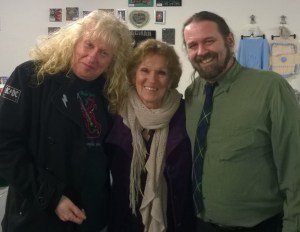
Jeff Jeffrey, Jess Smith and Rolf Campbell at the first public performance of the Tinkers’ Heart Song.
The song had its first live performance at the Artizan Gallery, Dumbarton on February 11th. It will also be performed at the Coach house, Cairndow, at Easter. Tinkers’ Heart Song


August 6, 2015
The Tinkers’ Heart (9)
The absolute joy we felt when we learned that the Tinkers’ Heart was granted its status as a Monument of National importance has not diminished in the slightest. If anything, it has grown and taken on a life of its own.
One of the things the campaigning committee wanted was to share and explore the culture of Scottish Travellers and their part in the story of Scotland. To that end, we’ve produced the first edition of a new magazine – The Heart of the Travellers Magazine. See what I mean about things taking on a life of their own?
The magazine is here: HOTT Mag Vol 1 Ed 1 Aug 2015
Just click to download – please enjoy!
Fiona


June 19, 2015
Pooka Pages Magazine for Pagan Kids
Lora Craig-Gaddis has written and produced this magazine for many, many years. It’s a wonderful resource for Pagan parents – and it is totally free. Pooka Pages Summer Solstice 2015
There are various contributors and the magazine is interesting, lively and full of good stuff. There are also lots of interesting craft ideas for small children, as well as colouring pictures and stories in both the magazine and on the website.
Please enjoy! Pooka’s website





